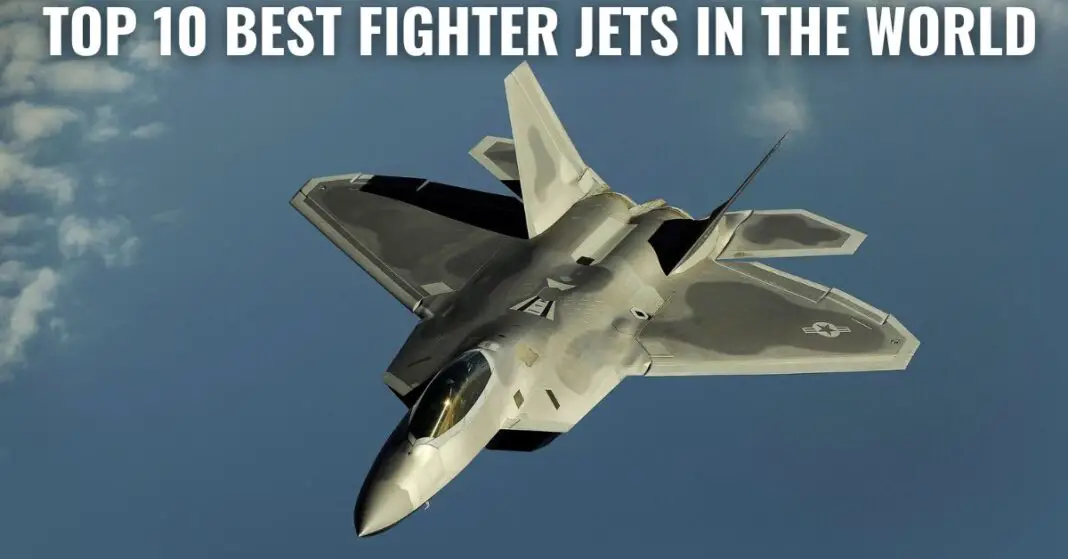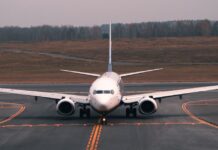Today, our world has amazing technology that changed how countries protect themselves and show their strength around the world. One area where this is very clear is in the development of advanced war machines, especially fighter jets. These jets are made to push the limits of speed, stealth, and how they fly, showing incredible progress in engineering, technology, and smart planning for battles.
In this article, we’ll explore the top 10 fighter jets. From the United States Lockheed Martin F-22 Raptor to Russia’s Sukhoi Su-57 and China’s Chengdu J-20, each of these planes represents their country’s skills in many high-tech areas and smart military planning. They’ve changed how battles work in big ways.
Table of Contents
Lockheed Martin F-22 Raptor
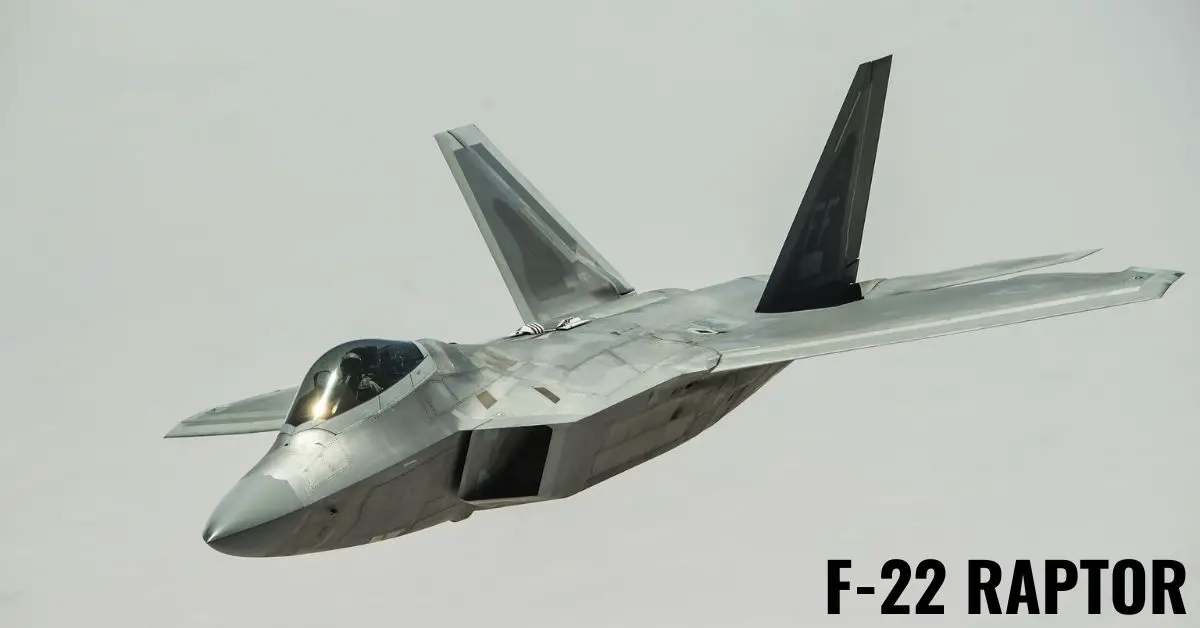
Few pieces of technology can command the awe and respect of the Lockheed Martin F-22 Raptor, a fifth-generation stealth fighter jet that has remodeled the entire landscape of aerial warfare. Not only does the Raptor exemplify the very epitome of top-tier engineering and design, but it also carries the honor of being the first operational aircraft to combine supercruise, supermaneuverability, stealth, and sensor fusion in a single platform.
Revolution Through Stealth
Stealth technology has been an increasingly prominent feature in military design, and the F-22 leads the pack. Its radar-absorbing materials and sharp edges can deflect radar signals, decreasing detectability. This allows it to bring unprecedented advantages to air-to-air combat, allowing it to fly closer to adversaries without detection, and giving it the first-shot advantage.
Superior Speed and Efficiency with Supercruise
The concept that truly sets the Raptor apart is supercruise, a capability that describes sustained supersonic flight without the need for afterburners. This means the F-22 can fly faster and farther on less fuel – a potent combination, enabling it to intercept targets more swiftly and maintain combat operations longer.
Enhanced Maneuverability for Unmatched Aerial Advantage
The F-22’s thrust vectoring nozzles give it excellent maneuverability and agility in air-to-air combat – its post-stall maneuvering capabilities give this bird of prey the upper hand in dogfights, establishing the F-22’s dominance in any aerial engagements.
The Future is Here: Sensor Fusion
The F-22 Raptor incorporates sensor fusion – a feature that combines data from different onboard systems into a simplified, easy-to-understand format for the pilot. This not only reduces the pilot’s workload but also provides a complete and accurate battlefield picture in real-time.
Potent Strike Power
Beyond the combat advantage, the F-22 Raptor brings extensive firepower. It is armed with AIM-120D AMRAAMs, and AIM-9M Sidewinders and can also carry 1,000-pound guided bombs. Its versatility allows it to carry out varied mission types such as air-to-air, air-to-ground, and even electronic attacks.
Standing Unchallenged in the Skies
In closing, the Lockheed Martin F-22 Raptor embodies the future of aerial warfare. It combines speed, surveillance, stealth, and a devastating strike capability into an unassuming package. Its revolutionizing presence in the field of technology and military aviation is a textbook case of how technology can overhaul traditional combat paradigms.
As modern wars move away from ground forces to more high-tech arenas, the F-22 will undoubtedly continue to assert its dominance. In every aspect, the F-22 Raptor is unchallenged, unparalleled, and unmatched, truly a testament to human ingenuity in transforming technological advancements into practical applications.
Sukhoi Su-57
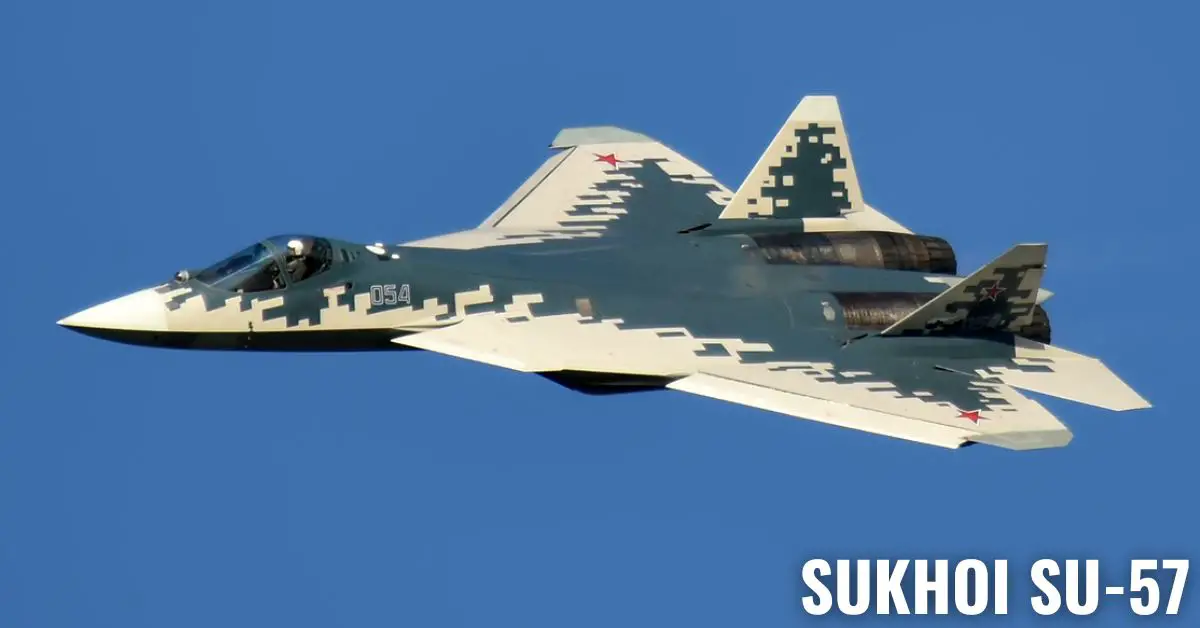
The Sukhoi Su-57, Russia’s fifth-generation fighter jet, poised to rival the F-22 Raptor, prompts high anticipation among military and aviation buffs around the globe. A champion amidst ultimate aircraft, the Su-57 showcases a myriad of features that enhance its stand-out stature.
Subjugating one of the Su-57’s powerful charms is its boldly engineered implementation of 3D thrust vectoring. This is actioned into two horizontally pivoted engines for refined maneuverability. Its design endeavors to pivot 360 degrees, enabling the jet to perform acutely angled maneuvers that ordinary aircraft find challenging. This not only heightens aerial dominance but also proffers a significant abrupt shift in the dynamic combat scenario.
Stealth technology may be given in fifth-generation fighter jets, yet the Su-57 stretches the boundaries with its meticulous blend of radar-absorbing materials and aerodynamic design. Its distinctive appearance absorbs radar wave emissions rendering it less noticeable, enabling it to elude enemy surveillance while perpetuating its serious surveillance capacities.
Adding another feather to its cap is the Sukhoi Su-57’s speedy cruising without the hankering for afterburners. This capability, otherwise known as “supercruise,” may be often correlated with the F-22, yet the Su-57 espouses this feature resplendently, which ensures a robust speed and conserves fuel for extensive missions, making it significantly versatile.
One more instrumental innovation of the Su-57 is the avant-garde L-band radar. As against the X-band radars conventionally used by fighter jets that are limited by weather conditions, the L-band radar extends its capabilities against a broader spectrum of targets. This colossal technological leap enables the Su-57 to detect challenging targets at much longer distances, crucial in both air-to-air and air-to-sea operations.
Key features of the Su-57 include:
Stealth: The Su-57 incorporates various stealth features aimed at minimizing its radar signature, rendering it less detectable by enemy radar systems.
Supercruise: Demonstrating the capability for supersonic flight without the need for an afterburner, the Su-57 gains a significant speed advantage over other fighter aircraft.
High Maneuverability: The Su-57’s design and powerful engines enable exceptional maneuvers, including tight turns and high-angle-of-attack flight.
Long Range: With a combat range exceeding 3,500 kilometers (2,175 miles), the Su-57 operates effectively over extended distances without requiring refueling.
Multirole Flexibility: Primarily designed for air superiority, the Su-57 exhibits versatility by being configurable for ground attack missions, employing a variety of air-to-surface weapons.
Chengdu J-20
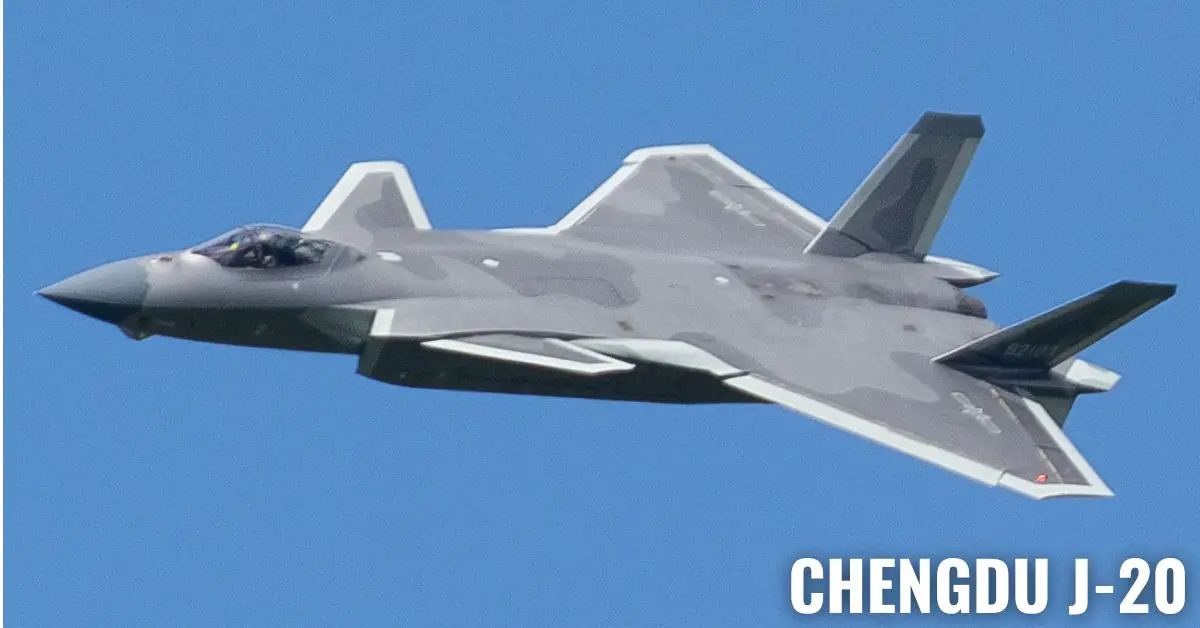
As we delve further into the futuristic marvel that is the Chengdu J-20, it becomes crystal clear that this formidable fifth-generation stealth fighter is indeed a testament to China’s burgeoning technological supremacy. Apart from the previously mentioned features such as the stealth design, advanced materials, emission management, sound suppression, state-of-the-art software, aerodynamic efficiencies, and integrated defense systems, other factors underscore the prowess of this cutting-edge aircraft.
Importantly, the Chengdu J-20 leverages its system-level design techniques and engineering execution to deploy a high degree of signature management. The aircraft is built to not just evade radar but to manage and obfuscate the data-driven models that adversaries might use to predict its behavior. From the shape of the plane to the materials used, everything is meticulously designed to reduce detectability.
Refined Radar Systems are a pivotal characteristic of the Chengdu J-20. The AESA (Active Electronically Scanned Array) radar systems are not only capable of detecting enemy aircraft at significantly greater distances but also exhibit resistance to electronic warfare attacks. It can perform search, target detection, tracking, and missile guidance simultaneously, giving it a multifaceted edge in aerial engagements.
Double Diverterless Supersonic Intakes (DSI) is another aspect that reflects China’s technological prowess. This unique intake design minimizes radar cross-section and infrared signature, ensuring stealth at supersonic speeds. It also simplifies the structure and maintenance of the aircraft, adeptly combining functionality, efficiency, and pragmatism.
The canard configuration instills the J-20 with high maneuverability, superior agility, and stability at supersonic speeds. This fighter jet excels in dogfights, displaying an improved angle of attack range and increased lift.
Key features of the J-20 include:
Advanced Avionics: The J-20 is equipped with a modern glass cockpit and a sophisticated suite of avionics, including an AESA radar, an electro-optical targeting system, and a helmet-mounted display. This technology gives pilots better situational awareness, targeting abilities, and support for decision-making.
Multirole Flexibility: While mainly made for air superiority, the J-20 can also be set up for ground attack missions, carrying various air-to-surface weapons. This versatility makes it effective and adaptable for different mission scenarios.
Continuous Upgrades: The J-20 keeps getting developed and improved, with newer versions having more advanced engines, avionics, and weapons systems. This ensures it stays relevant and competitive as technology evolves.
Long Range: With a maximum range of over 3,500 kilometers, the J-20 can cover long distances without needing to refuel. This gives it more flexibility and operational range.
Closed Development Program: Details about the J-20’s specific capabilities, like its stealth performance and engine type, are mostly classified because of the closed nature of the program.
Lockheed Marting F-35 Lightning II

The Lockheed Martin F-35 Lightning II constitutes a series of all-weather stealth multirole combat aircraft, each featuring a single seat and engine. Its design encompasses capabilities for air superiority, strike missions, electronic warfare, intelligence, surveillance, and reconnaissance.
Resulting of the Joint Strike Fighter (JSF) program, the F-35 emerged from a collaborative initiative between the United States Department of Defense and several allied nations. The objective was to develop a singular fighter aircraft capable of meeting the diverse needs of all participating countries.
The F-35 is accessible in three variations:
- F-35A: This conventional takeoff and landing (CTOL) variant is utilized by the United States Air Force and various air forces globally.
- F-35B: The short takeoff and vertical landing (STOVL) variant is employed by the United States Marine Corps and the United Kingdom Royal Air Force.
- F-35C: This carrier variant is in service with the United States Navy.
All three F-35 variants feature advanced sensors and avionics, including a potent radar, an electro-optical targeting system, and a distributed aperture system (DAS). The DAS comprises six infrared cameras mounted around the aircraft, providing the pilot with a 360-degree view of the surrounding airspace.
Additionally, the F-35 incorporates a helmet-mounted display (HMD) enabling the pilot to visualize through the airframe directly onto the target, conferring a substantial advantage in combat scenarios.
The F-35, a transformative force in air warfare, stands as the most advanced fighter aircraft globally and is poised to play a pivotal role in future military conflicts.
Key features of the F-35 include:
- Stealth: Engineered to be elusive to radar and other sensors, making it challenging for enemy aircraft to detect and engage.
- Supercruise: Capable of flying at supersonic speeds without the need for an afterburner, providing a significant speed advantage over other fighter aircraft.
- Sensor Fusion: Integrating sensors to offer the pilot a comprehensive battlefield picture, enhancing decision-making in combat.
- Networked Warfare: Designed to be seamlessly connected with other aircraft and ground forces, facilitating information-sharing and coordinated attacks.
While the F-35 is a subject of controversy, with some critics citing its high cost and questioning the value of its capabilities, others contend that it represents a crucial investment in national security.
Explore the differences between F-22 Raptor and F-35 Lightning II.
Eurofighter Typhoon

The Eurofighter Typhoon stands as a highly advanced, twin-engine, canard delta wing, multirole combat aircraft—a true European powerhouse collaboratively developed and manufactured by a consortium of leading aerospace companies from the United Kingdom, Germany, Italy, and Spain.
This remarkable aircraft is engineered to excel in a diverse array of missions, including:
- Air Superiority: With its advanced design and powerful engines, the Typhoon proves to be a formidable force in aerial combat. Its exceptional agility and maneuverability enable it to outclass and defeat adversary aircraft.
- Strike: The Typhoon can be armed with an array of weapons, including bombs, missiles, and rockets, facilitating precision attacks against ground targets.
- Air Policing: Leveraging its speed and range, the Typhoon is well-suited for air patrol and interception missions, safeguarding airspace from unauthorized incursions.
- Reconnaissance: Outfitted with various sensors, including a robust radar and electro-optical targeting system, the Typhoon excels at gathering valuable intelligence information.
Equipped with state-of-the-art technology, the Eurofighter Typhoon features:
- Eurojet EJ200 Engines: These powerful engines grant the Typhoon exceptional performance, boasting a top speed of Mach 2.495 and a range of up to 2,900 kilometers.
- Active Electronically Scanned Array (AESA) Radar: This advanced radar endows the Typhoon with a long detection range and high accuracy, enabling it to track and engage multiple targets simultaneously.
- Helmet-Mounted Display (HMD): Enhancing situational awareness, this system overlays vital information on the pilot’s visor, aiding in decision-making.
- Electronic Warfare Suite: Safeguarding the Typhoon from enemy radar and missiles, this suite ensures its survivability in combat situations.
- Advanced Cockpit: Designed for intuitive use, the Typhoon’s cockpit enables the pilot to focus on the mission, maximizing effectiveness.
Serving the air forces of several European nations, including the United Kingdom, Germany, Italy, Spain, Austria, Saudi Arabia, and Kuwait, the Eurofighter Typhoon is a testament to European technological prowess and collaboration. It remains a crucial asset in global air defense and security, with key features such as:
- Multi-Role Capabilities: Adaptable for various missions, the Typhoon proves versatile and cost-effective.
- High Performance: Boasting exceptional speed, agility, and endurance, the Typhoon stands as a formidable combatant.
- Advanced Technology: Equipped with cutting-edge technology, the Typhoon ensures effectiveness and survivability in modern warfare.
- Proven Track Record: Successfully deployed in combat operations, the Typhoon is relied upon by air forces worldwide.
- International Collaboration: Reflecting European aerospace strength, the Typhoon is a product of successful collaborative efforts within the European consortium.
Boeing F-15EX Eagle II

The Boeing F-15EX Eagle II, an evolutionary leap forward from the iconic F-15 fighter jet, is positioned to assert its dominance in the skies for decades to come. Building upon the heritage of the F-15E Strike Eagle, the EX variant incorporates state-of-the-art technology and advanced capabilities, solidifying its status as an exceptionally formidable aircraft.
Unmatched Performance:
Speed and Agility: The F-15EX achieves a remarkable maximum speed of Mach 2.5+, surpassing most adversaries. Its outstanding maneuverability facilitates close-quarters combat and seamless execution of complex aerial maneuvers.
Range and Endurance: With a combat range exceeding 1,272 km (791 mi), the F-15EX can reach distant targets and sustain operations for extended durations, making it well-suited for long-range strike missions and air patrols.
Payload Capacity: The F-15EX accommodates a substantial weapons payload, including air-to-air and air-to-ground missiles, bombs, and rockets. This adaptability allows it to meet diverse mission requirements and engage in various combat scenarios.
Cutting-Edge Technology:
Advanced Avionics: The F-15EX features a state-of-the-art cockpit equipped with a fly-by-wire system, integrated displays, and advanced sensors. This empowers pilots with heightened situational awareness, improved decision-making capabilities, and enhanced control over the aircraft.
Electronic Warfare Suite: Equipped with a sophisticated electronic warfare suite, the F-15EX is shielded from enemy radar and missiles, bolstering its survivability in high-threat environments.
Digital Fly-by-Wire System: This system delivers precise control over the aircraft, contributing to smoother flight performance and enhanced maneuverability.
Open Systems Architecture: The flexible architecture facilitates seamless integration of future technology upgrades, ensuring the F-15EX remains relevant and capable for decades to come.
Operational Advantages:
Low Maintenance Costs: Leveraging the extensive operational history of the F-15 platform, the F-15EX benefits from readily available spare parts, well-established maintenance procedures, and lower overall operating costs compared to developing an entirely new aircraft.
Proven Track Record: With an impressive combat history, the F-15 family, including the F-15EX, has demonstrated its effectiveness in numerous conflicts. This proven track record instills confidence in the aircraft’s capabilities and reliability.
Future-Proof Design: The F-15EX’s open systems architecture and modular design facilitate the easy integration of future upgrades and enhancements. This ensures the aircraft remains at the forefront of fighter technology, continually meeting evolving operational requirements.
Dassault Rafale

The Dassault Rafale stands as a French twin-engine, canard delta wing, multirole fighter aircraft designed and constructed by Dassault Aviation, representing a true marvel in modern aviation.
This remarkable aircraft fulfills a diverse array of roles, including:
Air Superiority: Leveraging its advanced design, powerful engines, and exceptional agility, the Rafale proves to be a formidable force in air-to-air combat. Its potent weapon systems and sophisticated radar enable it to dominate the skies and efficiently engage multiple targets.
Strike: Adaptable for various strike missions, the Rafale can be equipped with a diverse range of air-to-ground weapons. Precision targeting systems and laser designation capabilities ensure devastatingly accurate attacks against ground targets.
Reconnaissance: Outfitted with advanced sensors, including a powerful radar and electro-optical targeting system, the Rafale excels in gathering valuable intelligence information. This makes it invaluable for surveillance and reconnaissance missions.
Nuclear Deterrence: Playing a crucial role in France’s nuclear deterrence strategy, the Rafale is capable of carrying nuclear bombs and penetrating enemy air defenses.
Naval Operations: The Rafale M variant, tailored for naval operations, features reinforced landing gear and a tailhook for carrier landings. This versatility allows the Rafale to operate seamlessly from both land and sea bases.
Technological Prowess:
The Rafale is equipped with some of the most sophisticated technology available, including:
- Snecma M88 Engines: These powerful engines provide exceptional performance, with a top speed of Mach 1.8 and a range exceeding 3,700 kilometers.
- RBE2 AESA Radar: Featuring advanced radar technology, the Rafale enjoys a long detection range and high accuracy, enabling it to track and engage multiple targets simultaneously.
- Spectra Electronic Warfare Suite: This sophisticated suite shields the Rafale from enemy radar and missiles, ensuring survivability in hostile environments.
- Ominus Helmet-Mounted Display (HMD): Allowing the pilot to view vital information superimposed on their visor, the HMD enhances situational awareness and targeting capabilities.
- Open Mission Systems Architecture: With a flexible architecture, the Rafale seamlessly integrates future technology upgrades, positioning itself at the forefront of fighter jet technology.
Shenyang FC-31 Gyrfalcon

The Shenyang FC-31 Gyrfalcon, also identified as the J-31, stands as a Chinese prototype mid-sized, twin-engine, 5th-generation stealth fighter aircraft crafted by Shenyang Aircraft Corporation (SAC). Marking a significant stride for China’s aviation sector, this aircraft carries the potential to reshape the global fighter jet landscape.
The FC-31 showcases a distinctive twin-engine design featuring a canard delta wing configuration. Similar to the American F-22 Raptor and F-35 Lightning II, this design enhances maneuverability and agility, critical attributes for engaging in air-to-air combat.
Key features of the FC-31 encompass:
Stealth Technology: The aircraft incorporates stealthy elements such as radar-absorbent materials and shaping, reducing its radar signature and rendering it challenging to detect.
Advanced Avionics: Equipped with a sophisticated glass cockpit and an advanced avionics suite, including a potent radar and electro-optical targeting systems, the FC-31 enhances situational awareness and targeting capabilities.
Multirole Capacity: Designed for diverse missions, the FC-31 excels in air-to-air combat, ground attack, reconnaissance, and electronic warfare. It accommodates a varied arsenal, including air-to-air and air-to-ground missiles, bombs, and rockets.
Twin WS-13 Engines: Propelled by two domestically developed WS-13 engines, the FC-31 enjoys an excellent thrust-to-weight ratio and supersonic speed capability.
Potential for Future Upgrades: The FC-31’s open architecture facilitates seamless integration of future upgrades and enhancements, ensuring its sustained effectiveness and relevance in the ever-evolving realm of air combat.
KAI KF-21 Boramae
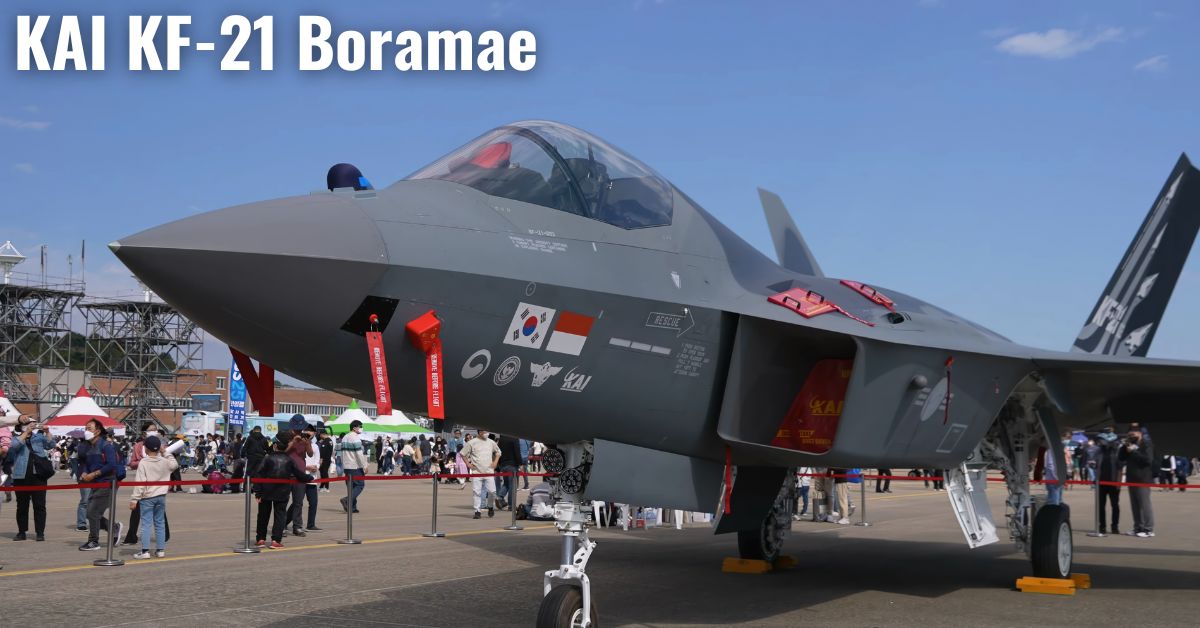
The KAI KF-21 Boramae, formerly designated as KF-X, stands as a South Korean-led initiative in fighter aircraft development, to create an advanced multirole fighter for deployment in the South Korean and Indonesian air forces.
This ambitious venture, led by Korea Aerospace Industries (KAI) and supported by Lockheed Martin, symbolizes South Korea’s vision of emerging as a key player in the global aerospace industry. The KF-21 is poised to be a formidable contender, leveraging a combination of cutting-edge technology and remarkable capabilities:
Design and Capabilities:
Stealthy Features: The KF-21 incorporates design elements like radar-absorbent materials and internal weapons bays, strategically aimed at minimizing its radar signature and enhancing survivability in combat scenarios.
Advanced Avionics: Outfitted with a modern glass cockpit and a sophisticated suite of avionics, including a powerful AESA radar and electro-optical targeting systems, the KF-21 provides pilots with exceptional situational awareness and targeting capabilities.
Multirole Versatility: Following in the footsteps of its predecessors, the KF-21 is engineered to excel in diverse missions, spanning air-to-air combat, ground attack, reconnaissance, and electronic warfare. It is configurable with an extensive array of weapons, encompassing air-to-air and air-to-ground missiles, bombs, and rockets.
Powerful Engines: Propelled by a pair of General Electric F414-GE-400K engines, the KF-21 boasts a superior thrust-to-weight ratio, enabling excellent maneuverability and achieving supersonic speeds.
Open Architecture: Adopting a design akin to the F-35, the KF-21 features an open architecture, facilitating the integration of future upgrades and technological advancements. This ensures its long-term effectiveness in evolving operational environments.
Sukhoi Su-35 Flanker-E

The Sukhoi Su-35 Flanker-E stands as a highly advanced, twin-engine, supermaneuverable air superiority fighter aircraft developed by the Sukhoi Design Bureau and manufactured by Sukhoi Corporation for the Russian Aerospace Forces. Evolving from the Su-27 Flanker, the Su-35 showcases substantial improvements in both performance and capabilities.
This aircraft features a distinctive canard delta wing configuration, delivering exceptional agility and maneuverability. Propelled by a pair of potent Saturn AL-41F1S turbofan engines, it attains speeds exceeding Mach 2.25. Additionally, the Su-35 incorporates stealthy elements, including radar-absorbent materials and internal weapons bays, enhancing its resistance to radar detection.
Key attributes of the Su-35 include:
Advanced Avionics: Boasting a modern glass cockpit and a sophisticated suite of avionics, the Su-35 is equipped with a powerful Irbis-E passive electronically scanned array (PESA) radar, an electro-optical targeting system, and a helmet-mounted display. These advancements elevate situational awareness, targeting capabilities, and overall pilot performance.
Multirole Flexibility: Primarily designed for air-to-air combat, the Su-35 exhibits versatility by being configurable for various missions, including ground attack, reconnaissance, and electronic warfare. It accommodates a diverse array of weapons, encompassing air-to-air missiles, air-to-surface missiles, bombs, and rockets.
Superb Maneuverability: The Su-35’s design, coupled with powerful engines, enables it to execute a broad spectrum of maneuvers, including tight turns and high-angle-of-attack flight, establishing its dominance in close-quarters air combat.
Long Range: With a maximum range surpassing 3,600 kilometers, the Su-35 operates effectively over extended distances without requiring refueling, enhancing its flexibility and operational reach.
Continuous Upgrades: Subject to continual technological enhancements, the Su-35 undergoes upgrades incorporating new technologies and capabilities, ensuring its sustained effectiveness against emerging threats.
What is the world’s strongest fighter jet?
While the F-22 Raptor and J-20 highlight impressive stealth and air-to-air capabilities, the F-35 distinguishes itself with versatile skills and the integration of advanced technology. The Su-57 stands out for its long-range and supercruise ability, whereas the F-15EX excels in payload capacity and endurance.
Ultimately, determining the “strongest” depends on specific priorities and combat scenarios, with each aircraft playing a role in the dynamic landscape of modern air warfare.
Which country has the best fighter jet?
The US takes the lead in stealth technology with the F-22 and F-35, while China’s J-20 presents a formidable challenge with its advanced tech, including stealth capabilities, although details remain limited. Russia counters with the Su-57, emphasizing supercruise and long-range capabilities, and the Su-35 excels in dogfights.
South Korea’s KF-21 Boramae, featuring an open architecture, promises future upgrades for multirole capabilities. The determination of the “best” fighter jet varies based on each nation’s unique needs and priorities, contributing to a dynamic and ever-evolving landscape in modern air warfare.
What is the fastest fighter jet?
While the YF-12 prototype takes the lead with an impressive speed exceeding Mach 3.3, the MiG-25 Foxbat holds the title for the fastest operational fighter at Mach 3.2. The F-22 Raptor closely follows at Mach 2.25, showcasing a powerful mix of speed, stealth, and advanced avionics.
Other noteworthy contenders include the MiG-31 Foxhound (Mach 2.83), Chengdu J-20 (estimated Mach 2.5+), and Sukhoi Su-57 (Mach 2), illustrating the diverse range of speed capabilities among fighter jets. However, it’s essential to recognize that speed is just one aspect of a complex puzzle, where factors such as maneuverability, stealth, range, and weapons systems play equally vital roles in determining a fighter jet’s overall effectiveness.


